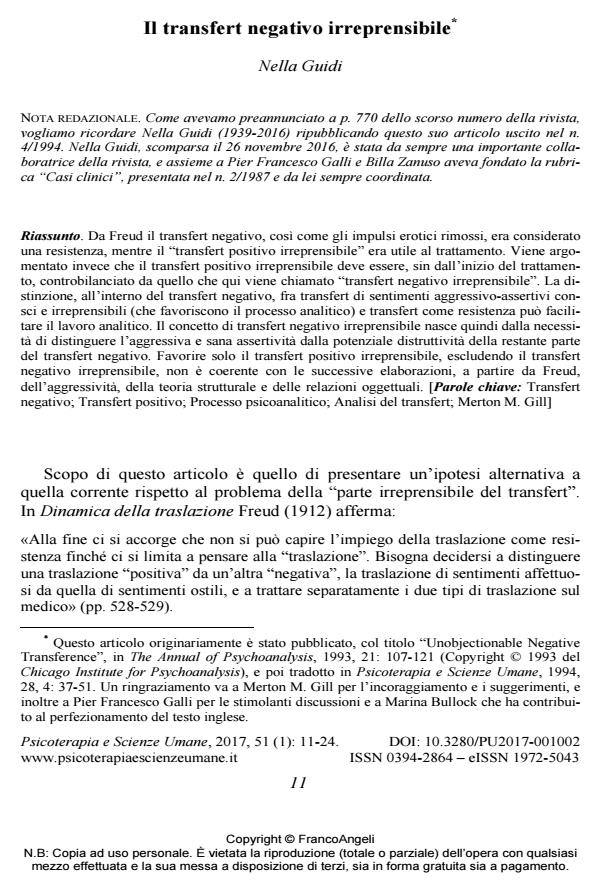Unobjectionable negative transference
Journal title PSICOTERAPIA E SCIENZE UMANE
Author/s Nella Guidi
Publishing Year 2017 Issue 2017/1 Language Italian
Pages 14 P. 11-24 File size 66 KB
DOI 10.3280/PU2017-001002
DOI is like a bar code for intellectual property: to have more infomation
click here
Below, you can see the article first page
If you want to buy this article in PDF format, you can do it, following the instructions to buy download credits

FrancoAngeli is member of Publishers International Linking Association, Inc (PILA), a not-for-profit association which run the CrossRef service enabling links to and from online scholarly content.
Freud in The Dynamics of Transference (1912) states that negative transference, like positive transference of repressed erotic impulses, has to be seen as a resistance. It is not so for the unobjectionable positive transference, which he insists is the vehicle of treatment. It is argued, instead, that the unobjectionable positive transference must be counterbalanced from the very beginning of analysis by the “unobjectionable negative transference”. The distinction, within the negative transference, between unobjectionable transference of conscious aggressive and assertive feelings (that facilitate the psychoanalytic process) and negative transference as resistance may help to induce the patient to better perform psychical work. The concept of unobjectionable negative transference is useful because it helps to distinguish aggressiveness or assertiveness in the transference from the potential destructiveness of the remaining part of negative transference. The use of only unobjectionable positive transference, excluding unobjectionable negative transference, is not consistent with the elaboration, beginning with Freud himself, of the vicissitudes of aggression, structural theory, and object relations. (This article by Nella Guidi first appeared in English in The Annual of Psychoanalysis, 1993, 21: 107-121, and in Italian in Psicoterapia e Scienze Umane, 1994, 28, 4: 37-51)
Keywords: Negative transference; Positive transference; Psychoanalytic process; Analysis of transference; Merton M. Gill
- Freud S. (1905). Tre saggi sulla teoria sessuale. Opere, 4: 443-546. Torino: Boringhieri, 1970.
- Freud S. (1908 [1909]). Analisi della fobia di un bambino di cinque anni (Caso clinico del piccolo Hans). Opere, 5: 481-589. Torino: Boringhieri, 1970.
- Freud S. (1912). Tecnica della psicoanalisi. Dinamica della traslazione. Opere, 6: 523-531. Torino: Boringhieri, 1974.
- Freud S. (1913). Nuovi consigli sulla tecnica della psicoanalisi: 1. Inizio del trattamento. Opere, 7: 333-352. Torino: Boringhieri, 1975.
- Freud S. (1924 [1925]). Autobiografia. Opere, 10: 71-141. Torino: Boringhieri, 1978.
- Freud S. (1925 [1926]). Inibizione, sintomo e angoscia. Opere, 10: 233-317. Torino: Boringhieri, 1978.
- Freud S. (1937). Analisi terminabile e interminabile. Opere, 11: 497-535. Torino: Boringhieri, 1979.
- Freud S. (1938 [1940]). Compendio di psicoanalisi. Opere, 11: 569-634. Torino: Boringhieri, 1979.
- Gill M.M. (1979). The analysis of the transference. Journal of the American Psychoanalytic Association, 27 (Suppl.): 263-288.
- Gill M.M. (1982). The Analysis of Transference. Vol. 1: Theory and Technique (Psychological Issues, Monograph 53). New York: International Universities Press (trad.it.: Teoria e tecnica dell'analisi del transfert. Roma: Astrolabio, 1985).
- Gill M.M. & Muslin H.L. (1976). Early interpretation of transference. Journal of the American Psychoanalytic Association, 24, 4: 779-794. DOI: 10.1177/000306517602400402
- Guidi N. (1985). Clinica e orientamento diagnostico dell’approccio psicoterapeutico all’adolescente. In: Rossi I., a cura di, L’adolescente, la famiglia, la comunità. Bologna: CLUEB, 1985, pp. 37-52.
- Rapaport D. (1953). Some metapsychological considerations concerning activity and passivity. Archivos de Criminología, Neuro-psiquiatría y Disciplinas Conexas (Ecuador), 1961, 9: 391-449 (trad. it.: Alcune considerazioni metapsicologiche riguardanti l’attività e la passività. In: Il modello concettuale della psicoanalisi. Milano: Feltrinelli, 1977, cap. XVI, pp. 321-360).
- Stein M.H. (1981). The unobjectionable part of the transference. Journal of the American Psychoanalytic Association, 29, 4: 869-892. DOI: 10.1177/000306518102900405
Nella Guidi, Il transfert negativo irreprensibile in "PSICOTERAPIA E SCIENZE UMANE" 1/2017, pp 11-24, DOI: 10.3280/PU2017-001002